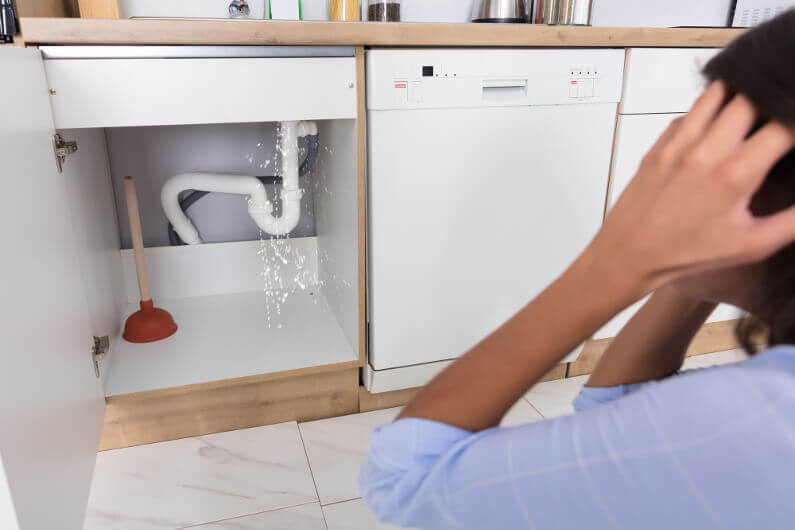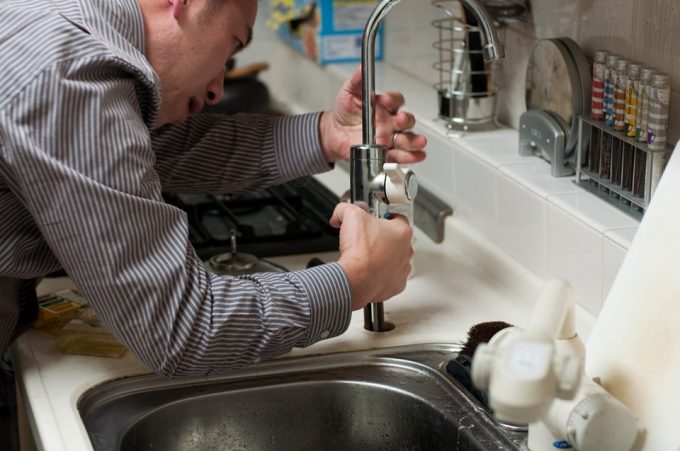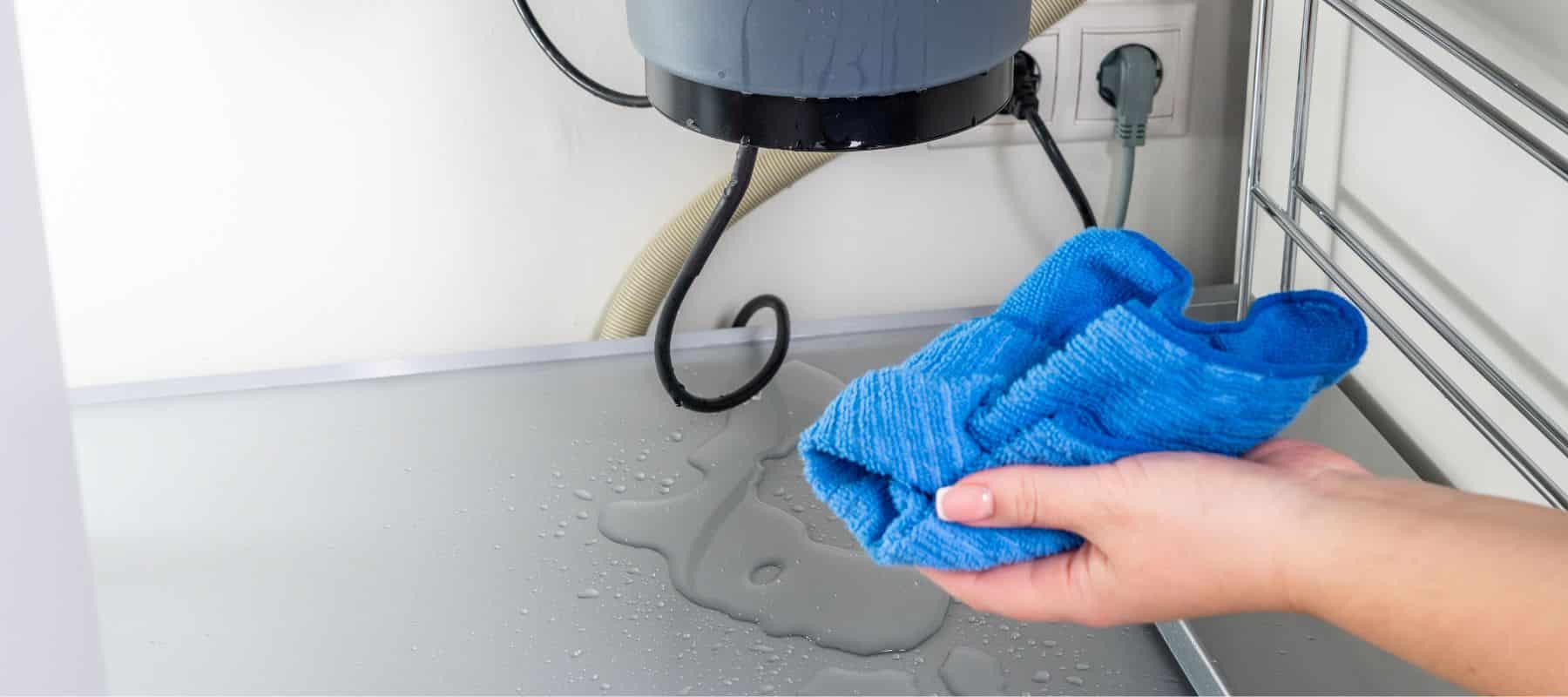
Common Causes of Leaks Under the Kitchen Sink
There are several potential reasons why your kitchen sink is leaking, ranging from loose connections to worn-out parts. Here are the most common causes of leaks under kitchen sinks:
1. Loose or Damaged Pipe Connections
The pipes under your sink may become loose over time, causing water to leak out of the joints. These leaks are often found at the U-shaped trap (P-trap), which is designed to prevent sewer gases from coming back up through the drain. If the connections between pipes aren’t tight, water can start leaking every time you use the sink.
2. Worn Out Washers and Gaskets
Washers and gaskets are small but essential components of your kitchen faucet and plumbing system. Over time, these parts can wear out, crack, or become loose, leading to water leaking from the faucet or beneath the sink. This is especially common in older homes where the washers or gaskets haven’t been replaced in years.
3. Leaky Drainpipe
The drainpipe connected to your sink may develop cracks, corrosion, or loosen over time, causing leaks. Leaky drainpipes are often caused by regular wear and tear or a buildup of debris that causes the pipe to deteriorate. A drainpipe leak can cause water to pool under the sink and, if left unchecked, lead to more significant water damage.
4. Clogged Garbage Disposal
If you have a garbage disposal installed, it could be the source of the leak. A clogged or damaged garbage disposal can cause water to back up and leak from the disposal unit or the surrounding plumbing. Check for leaks at the base of the disposal, as well as where the unit connects to the sink drain.
5. Faulty Sink Faucet
A leaky faucet isn’t just an annoyance—it can also lead to water pooling under the sink. If the faucet itself is faulty or has a worn-out seal, water can seep through and drip below the sink, leading to potential damage over time.
For more information on identifying plumbing leaks, visit this HGTV guide to fixing leaks.
How to Fix a Leak Under the Kitchen Sink

Fixing a leak under your kitchen sink depends on the source of the problem. Here’s a step-by-step guide to troubleshooting and fixing the most common causes of kitchen sink leaks:
| Step | What to Do |
|---|---|
| 1. Turn Off the Water Supply | Before you begin any repair work, turn off the water supply to the kitchen sink. Look for the shutoff valves located under the sink and turn them clockwise until the water is off. If the leak is severe or the shutoff valves aren’t working, turn off the main water supply to your home. |
| 2. Inspect the P-Trap and Drain Connections | Check the P-trap (the U-shaped pipe under your sink) and other pipe connections for any visible leaks. Tighten any loose connections with an adjustable wrench, and make sure the fittings are secure. If the P-trap is cracked or corroded, it will need to be replaced. |
| 3. Replace Worn-Out Washers or Gaskets | If the leak is coming from the faucet or other plumbing fixtures, the washers or gaskets may be worn out. Turn off the water, disassemble the faucet, and replace the washers or gaskets with new ones from a hardware store. Be sure to follow the manufacturer’s instructions for reassembly. |
| 4. Check the Garbage Disposal | If you have a garbage disposal, inspect it for leaks at the base and where it connects to the drain. If the unit is damaged or clogged, you may need to tighten the connections or replace the disposal entirely. Make sure to unplug the garbage disposal before inspecting or working on it. |
| 5. Replace the Drainpipe if Necessary | If the leak is coming from a cracked or corroded drainpipe, you may need to replace the damaged section. Turn off the water, remove the damaged pipe, and install a new one using pipe joint compound to ensure a watertight seal. |
| 6. Test the Repair | Once you’ve completed the repairs, turn the water supply back on and run the faucet for a few minutes. Check under the sink to see if the leak has stopped. If the area remains dry, your repair was successful. If the leak persists, you may need to call a professional plumber for further assistance. |
If you’re unsure how to fix the leak or if it requires more extensive repairs, Citywide Mold Mitigation can help with professional plumbing and water damage restoration services.
How to Prevent Future Leaks Under the Kitchen Sink

Regular maintenance can help prevent leaks from developing under your kitchen sink. Here are some tips to keep your plumbing in good condition and avoid future leaks:
1. Regularly Check for Loose Connections
Periodically inspect the pipes under your kitchen sink to ensure all connections are tight. Over time, pipe joints can loosen due to the vibrations from running water or using the garbage disposal. Tightening these connections can prevent leaks before they become a bigger problem.
2. Clean the Garbage Disposal
Keep your garbage disposal in good working order by cleaning it regularly and avoiding the disposal of items that can cause clogs, such as grease, fibrous vegetables, and coffee grounds. A well-maintained garbage disposal is less likely to cause leaks or drain backups.
3. Inspect the Faucet and Drain for Wear
Check your faucet and sink drain for any signs of wear and tear, such as corrosion or cracks. Replacing parts like washers, gaskets, or the faucet itself can help prevent leaks before they start.
4. Use a Sink Strainer
A sink strainer can prevent food scraps, hair, and debris from entering the drain and causing clogs. Reducing the amount of debris that goes down the drain can help keep your pipes in good condition and prevent leaks.
5. Install a Water Leak Detector
Consider installing a water leak detector under your kitchen sink. These small devices can alert you to a leak before it causes significant damage, giving you time to address the problem early.
For more tips on preventing kitchen leaks, check out this This Old House guide to fixing leaks.
FAQ
| Question | Answer |
|---|---|
| Why is there a leak under my kitchen sink? | Common causes of leaks under the kitchen sink include loose pipe connections, worn-out washers or gaskets, leaky drainpipes, clogged or damaged garbage disposals, and faulty faucets. |
| How do I stop a leak under my kitchen sink? | To stop a leak, turn off the water supply, inspect the pipes and connections for loose fittings or cracks, and replace any worn-out parts like washers, gaskets, or damaged pipes. If the problem persists, call a professional plumber. |
| Can a garbage disposal cause a leak under the sink? | Yes, a clogged or damaged garbage disposal can cause leaks. Inspect the garbage disposal for leaks around the base and where it connects to the drain. Tighten connections or replace the unit if necessary. |
| How can I prevent leaks under my kitchen sink? | To prevent leaks, regularly check pipe connections, clean the garbage disposal, inspect the faucet for wear, and use a sink strainer to prevent debris from clogging the drain. |
| When should I call a plumber for a leak under the kitchen sink? | If the leak persists after you’ve tightened connections or replaced parts, or if the issue is related to your garbage disposal or drainpipes, it’s best to call a licensed plumber to assess and fix the problem. |
If you’re dealing with a leak under your kitchen sink or have water damage concerns, contact Citywide Mold Mitigation for expert plumbing and water damage restoration services.

